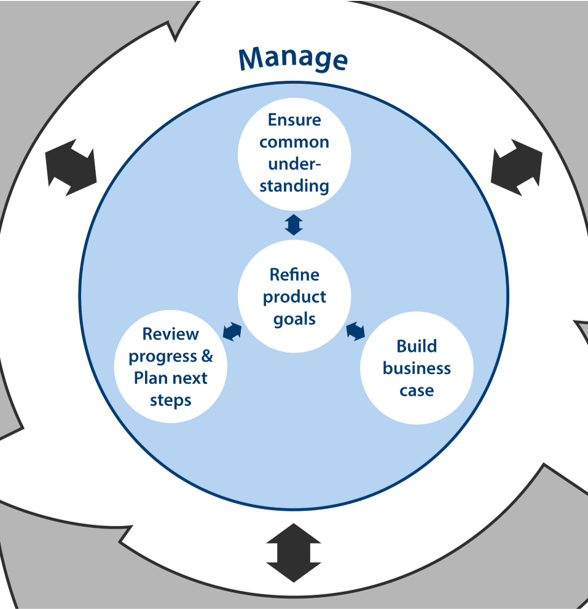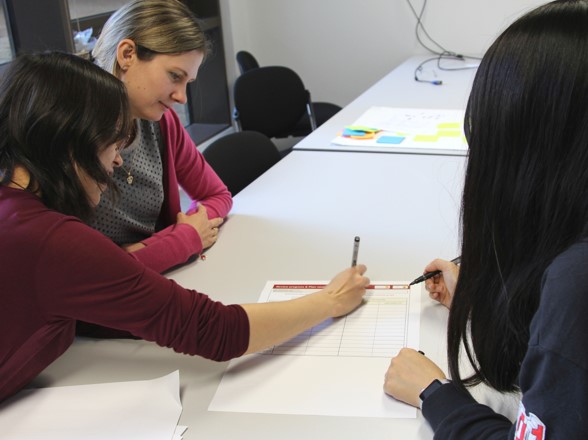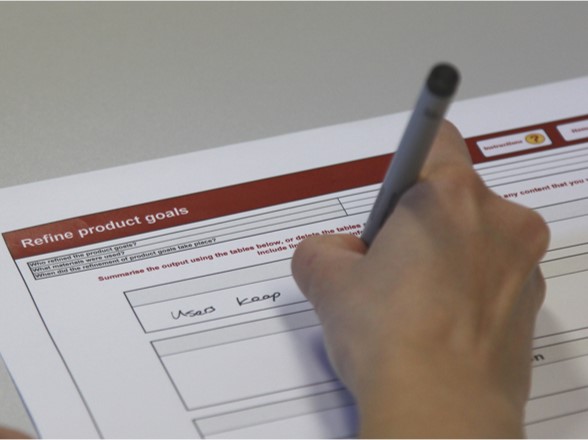The inclusive concept design process starts in the Manage phase, with ‘Review progress & plan next steps’. This page describes how to do this, as well as the other activities within the Manage phase. These activities can help you to manage an inclusive design project effectively, helping to determine what further work is needed and when to move to the next stage in your process.
On this page:
Manage activities answer the question ‘what should we do next?’. Go to full map.
Review progress & plan next steps
The starting point for inclusive concept generation is to review your current status and plan the next steps. The following questions help this activity:
- What have we got?
- What are we missing?
- What resources are available?
- What are the deadlines?
- What are the risks?
- What should we do next?
Reviewing and planning should continue throughout the project, monitoring the current level of confidence in:
Refine product goals
The product goals state the factors that will make the product different and better from others on the market. Determining and refining the goals of the product underpins the whole process of inclusive concept generation, as it provides focus and direction for all subsequent activities. The following questions can help this activity:
- What problem are we trying to solve?
- What are the big issues?
- What is the proposed solution and why is it different?
Reducing the problem statement and solution summaries down to one or two sentences helps to capture the real essence of what the product is aiming to achieve. These statements should be outlined at the beginning of the project, and updated and refined throughout concept development.
It is easy to get stuck in the detail and find it difficult to see the way forward. Such difficulties can often be resolved by referring back to, or clarifying the goals for the product.
While delivering the lead concept to market, the clear statement of product goals should be used to prevent subsequent decisions and compromises from eroding the concept’s strength.
Build business case
The business case demonstrates the product’s potential for profitability. Market success requires the product to be delivered at the right price point and profit margin. Achieving such commercial viability requires fit with the brand, technical feasibility, manufacturability, differentiation against competitors and more.
In order to build a business case, it is important to determine the factors that impact profitability, such as:
- Reduced cost of no fault found warranty returns
- Increased brand loyalty
- Widening the scope of the target market
This toolkit includes further Business case materials. These comprise an Excel spreadsheet for performing cost-benefit calculations, together with a list of cost-benefit case studies for inclusive design.
Further information
- Keates (2006)’s book: ‘Designing for Accessibility: A Business Guide to Countering Design Exclusion’ contains a chapter on ‘Making the Business Case for Accessibility’. This may prove helpful in thinking through the business case for an inclusive design project. (Published by Routledge).
- The website of Engineering Solutions On-Line offers a free Cost Benefit Analysis Template. This is an example of a generic cost-benefit tool, which may be helpful in thinking through some of the aspects of the business case.
Ensure common understanding
Ensuring common understanding is about having:
- A shared vision of the product goals
- Alignment with an agreed plan
- A common terminology
The first two have already been covered. To address the third, it is important to seek out and resolve the communication difficulties that can easily occur due to the diverse range of backgrounds amongst different stakeholders.
Acronyms and jargon benefit from being precise but may not be understood. Examples include ‘Wi-Fi’, ‘4G’ and ‘https://’. Conversely everyday words may appear to be understood but can easily be misinterpreted (e.g. user, client, customer, design and test). A glossary of terms can provide a simple but valuable solution to these issues.
Feedback
We would welcome your feedback on this page:
Privacy policy. If your feedback comments warrant follow-up communication, we will send you an email using the details you have provided. Feedback comments are anonymized and then stored on our file server. If you select the option to receive or contribute to the news bulletin, we will store your name and email address on our file server for the purposes of managing your subscription. You can unsubscribe and have your details deleted at any time, by using our Unsubscribe form. If you select the option to receive an activation code, we will store your name and email address on our fileserver indefinitely. This information will only be used to contact you for the specific purpose that you have indicated; it will not be shared. We use this personal information with your consent, which you can withdraw at any time.
Read more about how we use your personal data. Any e-mails that are sent or received are stored on our mail server for up to 24 months.






